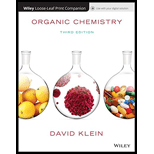
(a)
Interpretation:
The structure of Quiana has to be drawn.
Concept introduction:
(b)
Interpretation:
The
Concept introduction:
Polymers can be distinguished based on the functional group it has in the structure. The monomer considered for forming the polymer determines the functional group in the polymer. Few examples are,
- Acid +alcohol=polyester
- Acid+
amine =polyamide - Alcohol+phosgene=polycarbonate
- Alcohol+isocyanate=polycarbamate
(c)
Interpretation:
The polymer type of Quiana has to be determined.
Concept introduction:
Polymers can be classified as chain-growth and step-growth polymers. Chain-growth polymers are the one which are formed when monomer is added to the other monomer growing chain one at a time. This growing polymer chain usually has only one reactive site. This site is called growth point. Step-growth polymers are the one when the monomers react with each other to form oligomers. These oligomers are joined together to form polymers. This usually occurs when difunctional monomers are used. This has got two growth points.
(d)
Interpretation:
The polymer type of Quiana has to be determined.
Concept introduction:
Polymers can be classified as
Want to see the full answer?
Check out a sample textbook solution
Chapter 27 Solutions
ORGANIC CHEMISTRY-PRINT COMPANION (LL)
 ChemistryChemistryISBN:9781305957404Author:Steven S. Zumdahl, Susan A. Zumdahl, Donald J. DeCostePublisher:Cengage Learning
ChemistryChemistryISBN:9781305957404Author:Steven S. Zumdahl, Susan A. Zumdahl, Donald J. DeCostePublisher:Cengage Learning ChemistryChemistryISBN:9781259911156Author:Raymond Chang Dr., Jason Overby ProfessorPublisher:McGraw-Hill Education
ChemistryChemistryISBN:9781259911156Author:Raymond Chang Dr., Jason Overby ProfessorPublisher:McGraw-Hill Education Principles of Instrumental AnalysisChemistryISBN:9781305577213Author:Douglas A. Skoog, F. James Holler, Stanley R. CrouchPublisher:Cengage Learning
Principles of Instrumental AnalysisChemistryISBN:9781305577213Author:Douglas A. Skoog, F. James Holler, Stanley R. CrouchPublisher:Cengage Learning Organic ChemistryChemistryISBN:9780078021558Author:Janice Gorzynski Smith Dr.Publisher:McGraw-Hill Education
Organic ChemistryChemistryISBN:9780078021558Author:Janice Gorzynski Smith Dr.Publisher:McGraw-Hill Education Chemistry: Principles and ReactionsChemistryISBN:9781305079373Author:William L. Masterton, Cecile N. HurleyPublisher:Cengage Learning
Chemistry: Principles and ReactionsChemistryISBN:9781305079373Author:William L. Masterton, Cecile N. HurleyPublisher:Cengage Learning Elementary Principles of Chemical Processes, Bind...ChemistryISBN:9781118431221Author:Richard M. Felder, Ronald W. Rousseau, Lisa G. BullardPublisher:WILEY
Elementary Principles of Chemical Processes, Bind...ChemistryISBN:9781118431221Author:Richard M. Felder, Ronald W. Rousseau, Lisa G. BullardPublisher:WILEY





